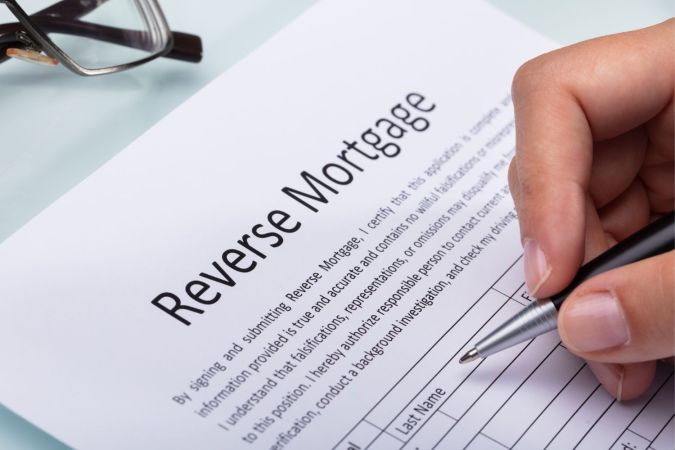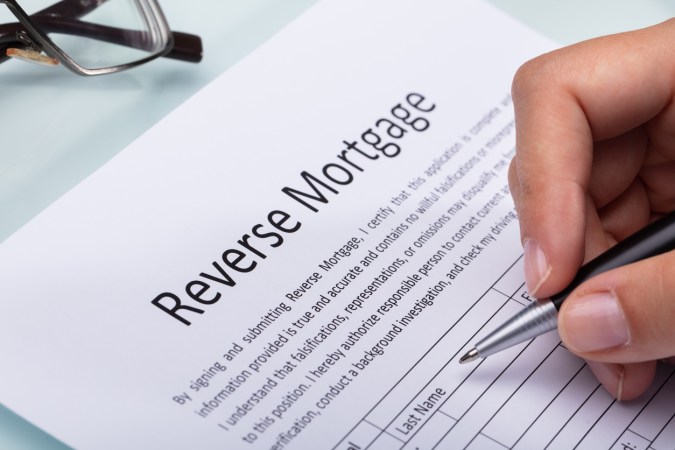We may earn revenue from the products available on this page and participate in affiliate programs. Learn More ›
It’s likely that many homeowners are familiar with the idea of cashing out the equity in their home to pay for things like home improvements or unexpected medical bills. In fact, there are several options when it comes to getting equity out of your home, including home equity lines of credit, cash-out refinancing, and home equity loans. Once homeowners know that they have enough equity to qualify for a home equity loan or line of credit, they will need to follow a series of steps to determine which, if any, of these options is best for their situation. Read on to learn how to get equity out of your home.
Before You Begin…
Are you wondering how to take out equity from your home? Homeowners will first need to be aware that not everyone will have enough equity in their home to qualify for a home equity loan or line of credit. Lenders typically require that homeowners have at least 15 to 20 percent equity in their home to be able to borrow from it. Homeowners will see an increase in their equity as they pay down their mortgage or when the value of their home increases. Home improvements can also build equity in the home. It will be important for homeowners to work with a lender to determine how much equity they have and whether it is enough to qualify for a loan, a refinance, or a line of credit. Different lenders may also have different loan-to-value ratio requirements (the amount borrowed against the value of the home) that could affect whether a homeowner can borrow from their home equity, so it’s important for homeowners to check with their current mortgage lender or shop around to find out what those requirements are.
So how do you get the equity out of your home? Homeowners should be aware that borrowing from their home’s equity can lengthen the loan term in some cases, meaning they will be making mortgage payments for a longer period of time. A second mortgage, which is another term for a home equity loan, can add a second monthly payment on top of the current mortgage payment. Homeowners will want to be comfortable taking on that extra financial burden. Home equity lines of credit and home equity loans use the home as collateral against the loan, which means a homeowner could lose their house if they fail to make on-time payments.

STEP 1: Decide how you want to spend your home equity funds.
Before applying for any type of home equity loan, a homeowner should have a good idea of what they need the money for. A home equity loan is a common type of home improvement loan that homeowners use to pay for upgrades or repairs to their house. The proceeds from a home equity loan can be used to fund projects that could increase a home’s value, allowing the homeowner to recoup some or all of the money borrowed against their home’s equity.
However, financing home improvements isn’t the only use for a homeowner’s equity; they can use it to pay for a variety of things. Some homeowners may use the money to pay down high-interest debts, pay for schooling for themselves or a family member, or pay unexpected medical bills. If the homeowner has considered other financial options and found that most come with high interest rates or longer loan terms, they may determine that using their home equity for these reasons could save them money on interest and be their best option.
STEP 2: Figure out how much equity you have in your home.
To start the process, a homeowner will want to determine how much equity they have in their home. The easiest way to do this is to talk to a mortgage lender. Homeowners can also calculate how much equity they have by subtracting the estimated value of their home from their current mortgage balance. To get the percentage, the homeowner would need to divide the loan balance by the current market value and multiply it by 100. For example, if a home is worth $300,000 in the current market and the homeowner’s mortgage balance is $120,000, the homeowner would have 40 percent equity in their home.
To find their current mortgage balance, homeowners can look at their monthly mortgage statement or check their account online. Homeowners may also want to have a real estate agent provide a market analysis of their home before beginning the loan process to find out what their home’s current market value is.
STEP 3: Check your eligibility for home equity financing.
For this step, homeowners may want to work with their current lender, who can guide them through the process of how to pull equity from a home. The lender can help them determine whether they’re eligible for a home equity loan. They can also tell the homeowner whether their home’s equity is above the threshold for being able to cash out that equity, which is typically 15 to 20 percent.
The lender can also tell the homeowner whether they are eligible for a home equity loan based on other factors and help them determine the best way to get equity out of a home. For instance, lenders often have other requirements for loan eligibility, including a good credit score and a low debt-to-income ratio. If their current lender won’t approve a home equity loan, homeowners can shop around and check with other lenders to see whether they qualify under other lender requirements.
STEP 4: Calculate how much equity you can use.
Homeowners can borrow against their home equity up to a combined loan-to-value ratio, which is usually up to 85 percent. This means that together, the mortgage and desired loan amount cannot exceed more than 85 percent of the home’s value.
For example, 85 percent of a home that is worth $300,000 would be $255,000. If the homeowner owes $120,000 on their mortgage, that means they could borrow another $135,000 using a home equity loan. Homeowners will work with their lender to determine how much equity they have in their home and the amount of money they can borrow, which will depend on the lender’s debt-to-income requirements.
STEP 5: Decide how much equity you want to pull from your home.
Now that the homeowner has hard numbers, they can determine how much money they want to pull from their home’s equity. Just because they are able to borrow a certain amount doesn’t mean they need to borrow all of it. Homeowners will need to pay back that amount with interest, which can potentially lead to a longer loan term.
The amount of much money a homeowner borrows from their equity will depend on what they plan to spend it on. As a general rule, homeowners should only borrow the amount of money they need for the project or bill they have it earmarked for. For instance, if a homeowner plans to use their home’s equity to add solar panels that cost $20,000 for the materials and installation, they will only need to borrow $20,000, even if their home’s equity is higher than that.

STEP 6: Review the different types of financing available to homeowners.
The next step is for the homeowner to review their financing options. There are three primary ways a homeowner can borrow money from their home’s equity. The first is a home equity loan, which works by paying a homeowner a lump sum of cash from their home’s equity. The homeowner will then pay back the loan over time on top of their existing mortgage. A home equity loan has several advantages, including being relatively easy to qualify for and offering favorable rates.
The second option is a home equity line of credit (HELOC), which works very similarly. With this type of loan, the money is available for the homeowner to use as needed, rather than as one lump sum. The homeowner may only need to use a portion of the funds available to them, and they will only make payments on the amount of money they actually borrow from the line of credit instead of the entire amount borrowed with a home equity loan.
The third option is cash-out refinancing. A refinance is when a homeowner takes out a brand-new mortgage and uses it to pay off the old one. With a cash-out option, homeowners receive a cash payment from their home’s equity, and the borrowed amount from the equity gets rolled into the new mortgage. Homeowners wondering how to get a home improvement loan may consider a cash-out refinance to help fund their home remodeling project.

STEP 7: Identify the right loan type and loan terms for your circumstances.
It’s important for homeowners to understand all the components of each loan type before making a choice. For instance, if they need a lump-sum payment to pay off a large and unexpected medical bill, a home equity loan or cash-out refinance may work best. If they prefer access to an available, rolling line of credit, a home equity line of credit may be best. A homeowner can work with their lender to compare cash-out refinancing versus a home equity loan or line of credit to determine which option is the best for them.
Homeowners will also want to determine how the loan payments will fit into their budget. Home equity lines of credit or home equity loans add another payment on top of the already existing mortgage payment, and the homeowner will need to make sure they have enough room in their monthly budget to pay it. A cash-out refinance will result in a single mortgage payment each month, but that new mortgage payment will likely be higher than the original mortgage payment or have longer terms. The homeowner will want to make sure they can pay this higher amount before moving forward with a cash-out refinance.
STEP 8: Shop around for the best financing terms.
Homeowners will want to shop around with different lenders to find the financing terms that are best for them. Different lenders may offer different interest rates, loan terms, and more, so shopping around allows homeowners to compare several options at once. Some websites even let people compare interest rates side by side from a variety of lenders.
However, homeowners may want to start by checking with their current lender to see what financing terms and rates are available. This will give the homeowner a baseline to compare other options against, and it might save money or be more convenient to stay with the same lender. If a homeowner chooses to stay with their current lender, they might ask whether the lender offers a loyalty discount or other such discounts.
STEP 9: Pick a loan provider with the right financing options for you.
Once a homeowner has several loan options to compare, they can choose the loan provider who has the best financing options for them. That lender might have the lowest interest rates or be able to offer the most favorable terms, such as a higher loan-to-value ratio for homeowners who don’t have as much equity. More favorable rates can mean lower monthly payments or a shorter loan term.
Certain loan providers may also be able to offer better mortgage rates to a homeowner who chooses cash-out refinancing. Some loan providers may offer more favorable terms than a homeowner’s current lender in order to gain business.

STEP 10: Apply for a home equity loan, cash-out refinance, or home equity line of credit.
The next step is for a homeowner to fill out the application form for their chosen loan, which many providers will let them do online through a secure portal. Homeowners will want to make sure they have pertinent information on hand, such as their Social Security number, tax information, pay stubs, bank statements, employment information, mortgage paperwork, and details on current debts and income. The lender may also need proof of additional income if applicable, such as money from rentals, pensions, or other sources. A lender will need to verify this information and will advise a borrower on what documents they’ll need to provide.
If the lender has not done so already, they may also run a credit check during the application process. It’s common for lenders to require that a homeowner have a credit score in the mid-600s or higher to qualify for a home equity loan. A strong credit score shows that the homeowner has demonstrated the ability to pay their bills on time, making the borrower less of a risk to lend to in the lender’s eyes.
STEP 11: Pay any lender fees and closing costs.
As with other types of home loans, homeowners may need to pay certain fees when cashing out their home equity. For instance, a cash-out refinance typically comes with closing costs just like a brand-new mortgage would. Mortgage closing costs usually range between 3 and 6 percent of the home’s purchase price.
Home equity loans and home equity lines of credit often also come with closing costs. These can include appraisal fees, credit report fees, insurance costs, filing fees, taxes, and title fees. Closing costs for these loan types can run from 2 to 5 percent of the total loan amount. Ideally, homeowners can be prepared to pay these by setting aside funds before closing. Alternatively, some lenders will allow the borrower to roll the closing costs into the new loan to pay them back as part of the monthly mortgage payment.

STEP 12: Close on the loan and access your funds.
After the homeowner has submitted their paperwork and has an approved loan, they will close on the loan and have access to their funds. How these funds are deposited will depend on the loan type. The money from a home equity loan or cash-out refinance is disbursed to the homeowner at closing as a lump sum, and the homeowner is free to use the money however they wish.
Home equity lines of credit act as a revolving credit line that is there for the homeowner to access as needed. The homeowner pays on the outstanding balance each month, and the amount of credit available replenishes, similar to a credit card. The draw period (the time in which the borrower can take money out) is often as long as 10 years or more. The repayment period begins after that and usually runs for 20 years. Homeowners can borrow as little or as much as they want up to the credit limit.
STEP 13: Repay your loan.
The final step is for the homeowner to repay the loan. The draw period on a home equity line of credit runs for a certain number of years, during which the borrower will be required to make interest-only payments. Once the draw period has ended, the homeowner will need to repay the amount borrower, plus interest, in addition to the monthly mortgage. With a home equity loan, the amount borrowed is deposited into the homeowner’s bank account, and then repayment begins soon after. This monthly payment is typically in addition to the homeowner’s mortgage payment.
With a cash-out refinance, a homeowner repays the loan as part of the new mortgage. As such, the new mortgage payments will usually be higher than the old loan payments, since they cover the amount that was borrowed against the home’s equity.
Homeowners wondering how to get the equity out of a home can follow these steps, which will help them calculate how much equity they have in their home and how much money they can borrow. Homeowners will also know how each loan type works going in so that they are taking on a type of loan that they are most comfortable paying back.








